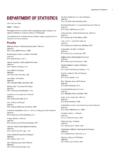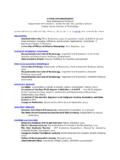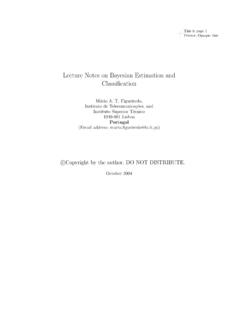Transcription of Convolutional Radio Modulation Recognition …
1 Convolutional Radio Modulation RecognitionNetworksTimothy J. O Shea1, Johnathan Corgan2, and T. Charles Clancy11 Bradley Department of Electrical and Computer Engineering, Virginia Tech, NGlebe Road, Arlington, VA Labs, Meridian Ave., Suite - , San Jose, CA study the adaptation of Convolutional neural networksto the complex-valued temporal Radio signal domain. We compare theefficacy of Radio Modulation classification using naively learned featuresagainst using expert feature based methods which are widely used todayand e show significant performance improvements. We show that blindtemporal learning on large and densely encoded time series using deepconvolutional neural networks is viable and a strong candidate approachfor this task especially at low signal to noise :machine learning, Radio , software Radio , Convolutional networks,deep learning, Modulation Recognition , cognitive Radio , dynamic spectrum access IntroductionRadio communications present a unique signal processing domain with a numberof interesting challenges and opportunities for the machine learning this field expert features and decision criterion have been extensively devel-oped, and analyzed for optimality under specific criteria for many years.
2 Howeverin the past few years the trend in machine learning applied to image processing[ ] and voice Recognition [ ] is overwhelmingly that of feature learning fromdata rather than crafting of expert features, suggesting we should evaluate asimilar shift in this wireless data demand is driving a need for improved Radio effi-ciency. High quality spectrum sensing and adaptation to improve spectral alloca-tion and interference mitigation is an important route by which we may achievethis. The FCC in the United States as well as counterparts in Europe are takingseriously and pursuing spectrum policy which leverages some of this ideas fromDynamic Spectrum Access (DSA)[ ], making clear the need for improved spec-trum sensing and signal identification algorithms allowing sensors and radios todetect and identify spectrum users and interferers at the best possible range andthus signal to noise such as DSA, opportunistic access and sharing of spectrum, and "Cog-nitive Radio " (CR) [ ], a more broad class of Radio optimization through learn-ing, have been widely discussed at the conceptual level.
3 Efforts in these [ ] 10 Jun 2016 Timothy J. O Shea, Johnathan Corgan, and T. Charles Clancyhowever have been constrained to relatively specialized solutions which lack thegenerality needed to deal with a complex and growing number emitter types,interference types and propagation environments. [ ] [ ] [ ]This is a significant challenge in the community as expert systems designedto perform well on specialized tasks often lack flexibility and can be expensiveand tedious to develop upon successful strategies from image and voice Recognition domainsin machine learning, we demonstrate an approach in the Radio using Convolu-tional Neural Networks (CNNs) and Deep Neural Networks (DNNs) which offersflexibility to learn features across a wide range of tasks and demonstrates im-proved classification accuracy against current day approaches.
4 Modulation RecognitionIn Dynamic Spectrum Access (DSA) one of the key sensing performed is that ofproviding awareness of nearby emitters to avoid Radio interference and optimizespectrum allocation. This identifying and differentiating broadcast Radio , localand wide area data and voice radios, radar users, and other sources of potentialradio interference in the vicinity which each have different behaviors and require-ments. Modulation Recognition then is the task of classifying the modulationtype of a received Radio signal as a step towards understanding what type ofcommunications scheme and emitter is can be treated as an N-class decision problem where our input is acomplex base-band time series representation of the received signal. That is, wesample in-phase and quadrature components of a Radio signal at discrete timesteps through an analog to digital converted with a carrier frequency roughlycentered on the carrier of interest to obtain a xN complex valued vector.
5 Clas-sically, this is written as in equation wheres(t)is a time series signal of eithera continuous signal or a series of discrete bits modulated onto a sinusoid witheither varying frequency, phase, amplitude, trajectory, or some permutation ofmultiple some path loss or constant gain term on the signal, andn(t)is an additive Gaussian white noise process reflecting thermal (t) =s(t) c+n(t)( )Analytically, this simplified expression is used widely in the development ofexpert features and decision statistics, but the real world relationship looks muchmore like that given in equation in many (t) =ej nLo(t) 0 =0s(nClk(t ))h( ) +nAdd(t)( )This considers a number of real world effects which are non-trivial to model: Modulation by a residual carrier random walk process,nLo(t), resampling by aresidual clock oscillator random walk,nClk(t), convolution with a time varyingrotating non-constant amplitude channel impulse responseh(t ), and theConvolutional Radio Modulation Recognition Networks addition of noise which may not be white,nAdd(t).
6 Each presents an unknowntime varying source of expert features and decision metrics optimality analytically undereach of these harsh realistic assumptions on propagation effects is non-trivial andoften forces simplifying assumptions. In this paper we focus on empirical mea-surement of performance in harsh simulated propagation environments whichinclude all of the above mentioned effects, but do not attempt to analyticallytrace their performance in closed form.. Expert Cyclic-Moment FeaturesIntegrated cyclic-moment based features [ ] are currently widely popular in per-forming Modulation Recognition and for forming analytically derived decisiontrees to sort modulations into different classes. In general, they take the formgiven in equation.
7 Snm=fm(xn(t)..xn(t+T))( )By computing the m th order statistic on the n th power of the instantaneousor time delayed received signal r(t), we may obtain a set of statistics whichuniquely separate it from other modulations given a decision process on thefeatures. For our expert feature set, we compute features. These consist ofcyclic time lags of and samples. And the first moments of the first powersof the complex received signal, the amplitude, the phase, and the absolute valueof phase for each of these train several classifiers on these set of expert features as a benchmarkcomparison. These leverage scikit-learn and consist of a Decision Tree, K= -Nearest Neighbor, Gaussian Naive Bayes, and an RBF-SVM. Additionally, wetrain a -layer deep neural network consisting only of fully connected layers ofsize , , and neurons.
8 Each of these is measured to provide a performancebaseline estimate for how a current day system operating on such a feature setmight perform. Best expert-feature performance is obtained from the SVM andDNN based approaches.. Convolutional Feature LearningWe evaluate several feature learning methods, but our principal method is thatof a Convolutional neural network (CNN) provided with a windowed input ofthe raw Radio time seriesr(t). We treat the complex valued input as an inputdimension of real valued inputs and user(t)as a set of xN vectors into anarrow D Convolutional network where the orthogonal synchronously sampledIn-Phase and Quadrature (I & Q) samples make up this -wide dimension. Evaluation DatasetWhile simulation and the use of synthetic data sets for learning is sometimesfrowned upon in machine learning, Radio communications presents a special case.
9 Timothy J. O Shea, Johnathan Corgan, and T. Charles ClancyTraining with real data is important and valuable - and will be addressed infuture work - but certain properties of the domain allow us to say our simulationis quite communications signals are in reality synthetically generated, and wedo so deterministically in a way identical to a real system, introducing modula-tion, pulse shaping, carried data, and other well characterized transmit param-eters identical to a real world signal. We modulate real voice and text data setsonto the signal. In the case of digital Modulation we whiten the data using ablock randomizer to ensure bits are channel effects are relatively well characterized. We employ robustmodels for time varying multi-path fading of the channel impulse response, ran-dom walk drifting of carrier frequency oscillator and sample time clocks, andadditive Gaussian white noise.
10 We pass our synthetic signal sets through harshchannel models which introduce unknown scale, translation, dilation, and im-pulsive noise onto our model the generation of this dataset in GNU Radio [ ] using the GNUR adio channel model [ ] blocks and then slice each time series signal up intoa test and traning set using a samples rectangular windowing process. Thetotal dataset is roughly MBytes stored as a python pickle file with complex bit floating point samples.. Dataset AvailabilityThis data will hopefully be of great use to others in the field and may serve asa benchmark for this domain. This dataset is available in pickled python , consisting of time-windowed examples and correspond-ing Modulation class and SNR labels. We hope to grow scope of modulationsaddressed and the channel realism as interest in this area.



![arXiv:0706.3639v1 [cs.AI] 25 Jun 2007](/cache/preview/4/1/3/9/3/1/4/b/thumb-4139314b93ef86b7b4c2d05ebcc88e46.jpg)
![arXiv:1301.3781v3 [cs.CL] 7 Sep 2013](/cache/preview/4/d/5/0/4/3/4/0/thumb-4d504340120163c0bdf3f4678d8d217f.jpg)
![@google.com arXiv:1609.03499v2 [cs.SD] 19 Sep 2016](/cache/preview/c/3/4/9/4/6/9/b/thumb-c349469b499107d21e221f2ac908f8b2.jpg)







